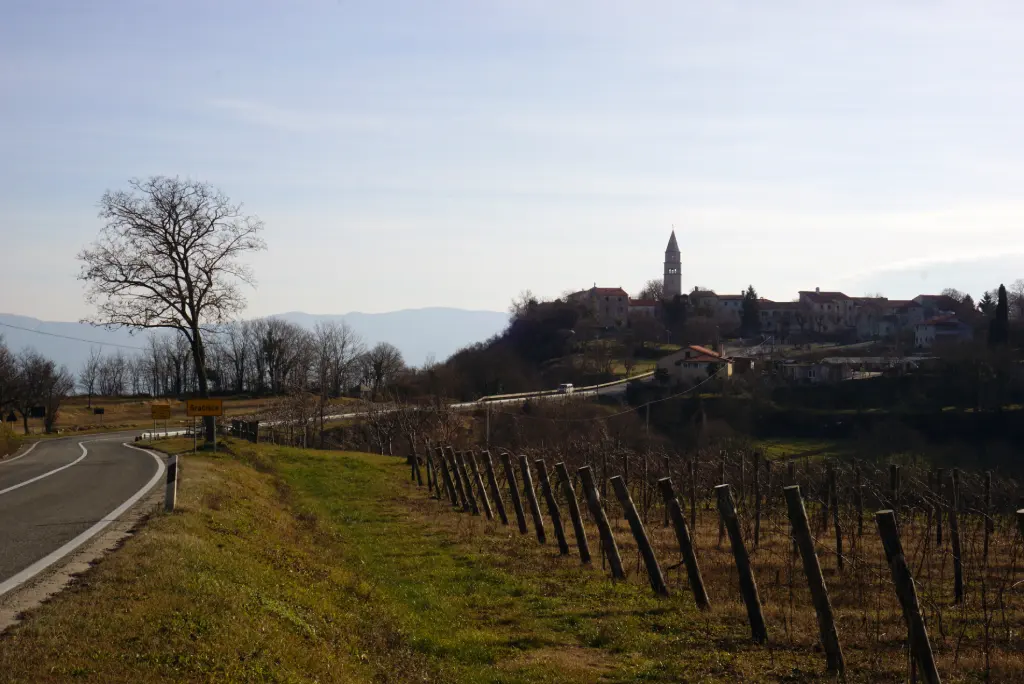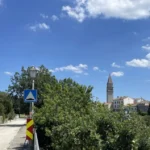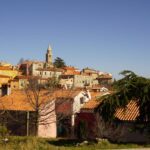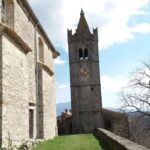Located in the central part of the Istrian peninsula on a 454 meters high hill, Gračišće is picturesque with breathtaking views.
While entering Gračišće which has risen on a living rock with steep slopes, one will see this place is an exciting spot foreveryone. One will enjoy the sites and heritage, while others would get into nature while hiking or cycling. Since the area is a Putokoza’s favourite spot, we prepared a shortlist with the ideas you can do and see in Gračišće, Istria. The town was first mentioned in the 6thcentury by the original name Callinianum given to it by the ancient Romans. They built a fortification on the Historian hillfort’s foundations.
Today is this a place that exudes the breath of the past in modern attire. The rural life of the medieval town and the sights of cultural heritage will allow the traveller to realize the authenticity of the town. Eventually, the tranquillity of the untouched natural environment will reveal the reason that central Istria is so wonderful. For example, stepping ontoPreševac Hill next to the town, which bears a nameafter the highest Slavic deity Perun, we can still feel the heritage of the spiritual life of the ancient Slavs.
Travelling central istria: G means Gračišće, a town with the medieval spirit
The ancient place on a hill surrounded by a green landscape and magical white land will reveal a chest with the treasures of Istria in the true sense of the word. Today, the place is built on a hill, which encourages the creation of works of art. It was not accidentally targeted by conquerors and rulers: Avars (6thcentury), Pazin County (1498) when it bears the name of Gaul and the Venetian Republic itself. The name roof which was also known as “Galliganana” is given by Gauls.In the first German land register from 1498, it is mentioned under the name Galliann, while in 1199108 families immigrated from Croatia. Twenty years later, Gračišće and Pazin have 120 hearths, which was the same number. In the 14th and 15th centuries, Gračišće became numerically and economically stronger than nearby Pazin, the capital of the county of the same name.
Things to do in Gračišće
Gračišće is characterized by a large number of monuments of cultural significance that testify to the long tradition of living in this area, as well as preserved natural beauty and views. The preserved medieval structure and numerous cultural monuments are proof that Gračišće is a place marked by various historical periods. They make it unique. We will be enchanted by the stone architecture and defensive walls with views of untouched nature. Today, Gračišće has a couple of taverns offering gastronomic and traditional specialities.
Learn about the Middle Ages legacy while walking the narrow streets of Gračišće
A tour of a small town that rises on a living rock with steep slopes at first glance seems easy. However, since it has a considerable number of details of narrow streets, this town offers much more than it seems at first glance. Even before entering the town, we will notice the defensive tower from 1500. It represents the ring of the city wall. The gate of the tower served as an entrance for the inhabitants of the surrounding villages, who came to the city seeking the services of craftsmen.
Just after we pass through the stone city gates, we will soon discover this place has not only an interesting history written in every corner of it but is filled with the ancient charm of the past. That past is reflected in the details of the narrow streets. One of the ones to go through ” Under Fumija” is especially interesting. In it, it is possible to notice some of the houses from the 15thcentury. It was a craftsman’s street. One of them, a blacksmith, carved a hammer, a symbol of his craft, on his door in 1451. An interesting fact is from 1498, which says that the citizens should have paid 137 marks for taxes. This was the highest tax rate, which was only 25 marks at the same time compared to Pazin.
Admire city Lodge with a statue of John of Nepomuk and Solomon’s Palace
One of the medieval symbols is the town lodge from 1549. It used to serve as a hall for city councillors. A statue of Ivan Nepomuk (18th century) can be seen on the front. He is believed to have been the protector of bridges. A similar statue dedicated to Nepomuk can be seen in other small Istrian places such as Tinjan, and Pićan, but also in Europe such as Prague.
Finally, we say that the most famous monument in Gračišće is Solomon’s Palace. Built of finely cut stone, it dates back to the 15th century. The Gothic style is recognized on the first floor of the building, while on the higher floors we see the Renaissance. It is believed that Gračišće played a special role in that period. It acquired the status of a city ( Statll ) as well as the coat of arms in 1578. The old coat of arms of the place consists of a shield with a two-storey tower with a pointed roof and buildings with arched windows shown behind it. After that period, it belonged to thePićan Diocese until its abolition in 1788.
Visit the parish Church of Saint Vitus with a mystical courtyard of unforgettable views
Once a town with seven churches, today it is recognizable by the three-nave baroque basilica of St. Vitus, Modesto and Crescenciusdating back to 1769. Apart from the fact that its interior has seven baroque altars and a statue of St. Vitus, a model in hand depicting the city during the 15thcentury is also a valuable listing. A peaceful and tranquil spotis the courtyard of the patron saintin front of the church. There is an interesting bell tower, 30 meters high.
Depending on the time of year, we will notice leaves from trees, greenery or the smell of flowering, and interesting details of the defensive wall monuments. And the most charming thing is the vistas. Yes, it is the view extending of central Istria:Pićan, “ĆepićkoPolje”, and the green fields. On a sunny day and the peaks of Učka offer the greatest inspiration.
Pay attention to the small churches
In addition to the largest parish church, Gračišće has several others. And each of them will conjure up the past of the place in some way. We will walk along with the church of the Blessed Virgin Mary dating back to 1425 with a shovel from the 17th century. The late Gothic church is attributed to the master Dent, who built it on the right side of the city gates, by order of the local nobleman PetarBeračić, one of the privileged patricians of the social class at the time. This fact testifies that in the Middle Ages there was a privileged class, which had the money to build churches and palaces like Solomon’s Palace. The table of judges is next to the church.
Gothic Church of St. Anthony from 1381 and renovated in 1486, the best preserved of the five churches in Gračišće. The forty-second bishop of Pićan, Paskazije, restored it to serve as a chapel for the bishops of Pićan. Church of St. Euphemia, named after the same saint as the largest, most famous church in Rovinj, is located on the steepest edge of the Gračišće slope. It dates from 1383 and was rebuilt in 1864. The church is simple, built of carved stone blocks of grey stone typical of this part of Istria. It faces west. Six steps with a semicircular floor plan lead to the entrance, and there is a round window above it. The façade is adorned with a transept with a window for two bells installed after 1985.
Bonus thing to do in Gračišće: attend the Saint Vitus feast
In recent times, Gračišće is increasingly recognizable by numerous events, many of which have grown into traditional festivities. The oldest and most significant of the manifestations is ” Vidova “, which is celebrated in honour of St. Vitus the patron saint of the saint after whom the Parish Church in Gračišće is named. The same day is also marked as the day of the Municipality.
Gračišće Outdoor
The fact that makesGračišćea special spot is the local hiking trail ” SaintSimon (Sv. Šimun) “. Hiking spots are a paradise for hikers or photographers who like to enjoy the beautiful panoramas. At the very entrance to the place, next to the palm tree, there is the starting point of the trail, which passes through untouched nature and picturesque places. In addition to unforgettable views, untouched nature and picturesque villages follow us all the way. And that’s not all!

Descending into the valley following the markings, we come to the old bridge and the Sopot waterfall, an attractive phenomenon. The waterfall is located in an area-specific for limestone sediment. So it makes that lowest point of the circular hiking trail a picture-perfect spot. In addition to the sound of the water flow, this is one of the most beautiful waterfalls in Istria.
Local tip eats & drink. In addition to being known as the central Istrian culture destination, Gračišće has, much gastronomical offer. The point where I used to stop while visiting Gračišće is a tavern. With a variety of Istrian food, this tavern offers a rest after sightseeing or walking around the St. Simon Path.
Daily tours from Gračišće
Located in the very centre of Istria, the Gračišće area is picturesque and offers various directions to go. Besides it is bounded by the stunning Istrian hilltops in its surroundings, you’ll get some new inspiration wherever you decide to go. Here we prepared just a few of the ideas.
Pazin
Also known as a place that encourages adventure, magical Pazin became famous after Jules Verne mentioned it in his novel Mathias Sandorf (Paris, 1885). The hero manages to escape from the castle located above the Pazin Abyss.
In addition to trying the zip line adventure over the Pazin cleft, you’ll want to visit the castle, which dates back to the 10th century and features an appearance from 1540.
Pićan
Located on the hill 335 meters above sea level at the site of the prehistoric hillfort reused by the Romans (that used to call it Petina), Pićan is known to be the centre of the smallest diocese in Istria in the period from antiquity (524) to 1788. The diocese was founded by St Nicephorus. Pićan was also the seat of government during the Byzantine Empire.
I like to stroll the picturesque town that should be entered through the 14th century preserved town gates where the hot oil and water were thrown at the attackers who wanted to conquer the city. While strolling the tiny cobblestone streets of Pićan, you’ll sure step back in time. But the thing which will get you the most inspiration is probably the stunning view that will be uncovered only after you walk almost all of its streets. The view extends of “Ćepić Polje” (Ćepić valley) seems to be so calm for the eyes. After taking the photos of this green view, look at the few churches in Pićan, such as the Romanesque church and St. Rocco from the 17th century.
Labin
Labin is a town in Istria located along the coastal road Pula-Rijeka in eastern Istria. Living on a 264 meters high hill, this medieval city dominated by rows of houses with painted facades is an excellent point to fill your batteries from your daily routine.
Once a mining town for one month in 1921 proclaimed as a “Republic” today is the most known to be the “Labin Art Republic”. Such is the synonym not only honoured to this part of history but also for as also proclaiming it to be an artistic city.
Getting to Gračišće
📍GPS: Latitude: 45.220360. Longitude: 14.010120.
✈️ By Air. Pula Airport is the nearest one. Rijeka Airport which is approximately 54 kilometres far away is a good alternative. The other airports may include Trieste airport (145 km), Venice Airport (255 km), Zagreb airport (230 km), and Ljubljana airport.
🚌 By Bus. The nearest bus station connecting the lines running from all the bus stations in Croatia is located in Pazin which is 15 kilometres distance from. Some international routes from the bus stations over Europe run to Pazin. However, for each Gračišće you’ll need a private transfer or hire a car from Pazin.
🚆 By Train. The train station is the same as a bus located in Pazin. In case you want to travel by train, you can reach Pazin from several directions such as Zagreb or Ljubljana.
🅿️ Parking. There is a parking lot located at the town entrance.



